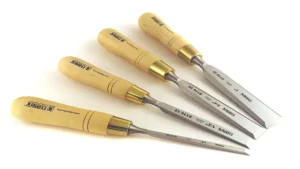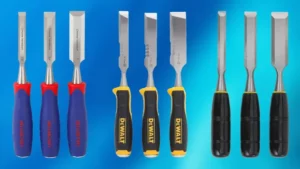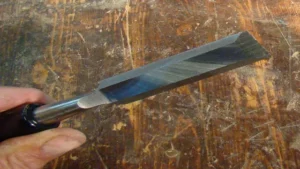Chisels are one of the most versatile tools in a woodworker’s arsenal. From carving intricate designs to removing rough edges, chisels make woodworking tasks much more manageable. However, there are various types of chisels available, each designed for a specific function.
Knowing the appropriate chisel type for a task can help ensure a clean and precise cut. In this blog post, we will explore the types of chisels and their uses, providing insight into the best chisel for any woodworking project. So, grab a cup of coffee, sit back, and let’s dive into the world of chisels.
Overview
If you’re curious about how many types of chisels are out there, you’ll be pleasantly surprised to learn that there are many different kinds. Chisels are versatile tools used for cutting or carving various materials such as wood, metal, stone, and even ice. There are several types of chisels, including bench chisels, mortising chisels, paring chisels, carving chisels, and slick chisels.
Bench chisels are the most common and are used for general woodworking tasks. Mortising chisels have a long, square-shaped blade and are used for creating deep, narrow holes. Paring chisels have a thin blade and are used for delicate work, such as trimming joints.
Carving chisels come in various shapes and sizes, each designed for specific carving tasks. Finally, slick chisels have a large, heavy blade and are used for tasks that require a lot of force. Knowing the different types of chisels and their uses can help you select the right one for any job you encounter.
What is a chisel?
A chisel is a tool that is used to shape and carve hard materials such as wood, stone, or metal. It typically consists of a sharp, metal blade that is held in place by a wooden or plastic handle. The two main parts of a chisel are the blade and the handle, which are used to apply force and control the direction of the tool.
Chisels come in a wide variety of shapes and sizes, each designed for a specific use. Some chisels are designed for cutting straight lines, while others are designed for carving intricate designs. The key to using a chisel effectively is to apply the right amount of force and to maintain control over the blade.
With practice, anyone can become proficient in using a chisel to create beautiful and intricate woodwork, stone sculptures, or metal designs.

Purpose of chisels in woodworking and crafting
Chisels are one of the most fundamental tools in woodworking and crafting. They are instrumental in shaping and carving wood or other materials by removing small chips or shavings. These handy tools come in different shapes and sizes to fit various applications.
From heavy-duty mortising chisels to fine carving chisels, each one serves a specific purpose. Some chisels have flat edges ideal for cutting straight lines, while others have curved edges ideal for carving intricate designs. Chisels are also used to make joints and slots necessary for furniture-making and construction.
These versatile tools allow you to create precise and detailed cuts that add depth and character to your work. Additionally, properly maintaining your chisels can prolong their lifespan and ensure optimal performance. Overall, chisels are indispensable tools for those who want to bring their woodworking and crafting skills to the next level.
Classification of Chisels
If you’re a woodworker, DIY enthusiast, or simply love crafting, then you know how essential chisels are for your toolbox. Chisels come in various shapes and sizes, and their uses can range from delicate carving to heavy-duty construction work. There are six main types of chisels: bevel edge chisels, mortise chisels, paring chisels, firmer chisels, carving chisels, and slick chisels.
Bevel edge chisels have a sharp edge and beveled sides, making them perfect for general-purpose cutting tasks and detailing. Mortise chisels are heavy-duty, with a thick blade that can withstand pounding with a mallet, making them ideal for creating joints. Paring chisels are slender and delicate and are best used for shaving thin layers or making precise cuts.
Firmer chisels have thicker blades and are ideal for cutting through tough materials such as hardwoods, while carving chisels feature a range of blade shapes designed for intricate carving work. Slick chisels are similar to firmer chisels in shape but are often wider and have a straighter edge, making them perfect for smoothing and leveling rough surfaces. With this overview, you can decide which chisels will be best for your future projects.
Based on Shape
When it comes to woodworking, chisels are a crucial tool for shaping and carving the material. But did you know that chisels actually come in different shapes? Understanding the classification of chisels based on their shape can help you choose the right tool for the job. One of the most common types of chisels are the straight chisels, which have a flat blade and are used for general purpose tasks such as cutting or paring.
Another type is the skew chisel, which has a blade that is angled from the handle and is primarily used for making angled cuts and smoothing rough surfaces. A gouge chisel has a curved blade and is perfect for making rounded cuts and carving intricate designs. On the other hand, a fishtail chisel has a blade that is narrow and then widens towards the handle, which allows for precise cuts in tight spaces.
Finally, a mortise chisel has a thicker, rectangular blade and is designed specifically for making mortise joints in woodworking projects. By understanding the different shapes and uses of chisels, you can choose the right one for your woodworking needs.
Bevel-Edged Chisels
When it comes to woodworking, choosing the right tool can make all the difference in the finished product. One of the most essential tools a woodworker needs is a chisel. Chisels can be classified based on their shape and size, and one type that stands out is the bevel-edged chisel.
These chisels have a slanted edge on one or both sides, making them perfect for cutting into wood with precision. The beveled edge ensures that the chisel doesn’t get stuck in the wood, and the angled edge allows for a more controlled cut. These chisels are perfect for making clean lines and detailed shapes, and are a must-have for any woodworking project.
Whether you’re a beginner or an expert, a bevel-edged chisel is an essential tool in your kit for achieving professional results.
Mortise Chisels
Mortise chisels are an essential tool for any woodworker, but not all chisels are created equal. There are various types of chisels used for different purposes, and it’s essential to know which one to use for what task. Mortise chisels, also known as square chisels, are specifically designed for making square or rectangular cuts in wood pieces.
They come in various sizes and shapes, with the most common being the standard size that’s around 1/4-inch to 1-inch wide. Mortise chisels have thick and sturdy blades that can withstand heavy blows from a mallet, making them ideal for creating mortises, which are square or rectangular holes in a piece of wood. They also have sharp corners that allow them to make sharp and clean cuts, which is essential for multiple woodworking tasks.
Sash or Paring Chisels
Chisels When it comes to woodworking, chisels are an essential tool. But did you know that there are different types of chisels that serve different purposes? One way to classify chisels is based on their size and shape. Sash chisels are long and slender, and their blades are usually around 2 inches wide.
They are often used for delicate, precision work, such as cutting joints and grooves. Paring chisels, on the other hand, have longer, narrower blades that taper to a point. They are great for trimming and shaping wood, and are often used to refine joints after the initial rough cuts are made.
Both sash and paring chisels require a steady hand and precise technique, and are beloved by woodworkers who appreciate the satisfaction of creating perfectly crafted pieces.
Based on Size
When it comes to chisels, there are a variety of classifications to consider. One of the primary ways chisels can be classified is based on their size. Small chisels typically have blades under one inch and are great for intricate work like carving details or mortising hinges.
Medium chisels usually have blades between one and two inches wide and are versatile for a range of tasks from chopping and paring to fitting joints. Large chisels can have blades over two inches wide and are great for heavy-duty tasks like timber framing and rough carpentry. It’s important to choose the right size chisel for the job to ensure accuracy and efficiency.
Bench Chisels
Bench chisels are indispensable tools for any woodworker or carpenter. These chisels distinguish themselves from other types by their size and shape, which has a significant impact on the type of work they are suitable for. The classification of bench chisels is based on their blade width and the length of their blades.
Generally, bench chisels have blades that range from 1/8″ to 2″ and come in various lengths, such as 4″, 6″, and 8″. The width of the blade determines the amount of wood that can be removed with each strike, while the blade length affects the overall stability and accuracy of the chisel. Different sizes and lengths of chisels are required to complete different tasks, ranging from intricate detailing to roughing out large areas.
Having a good mix of several size chisels is essential when tackling a complex woodworking project.
Detailing Chisels
Chisels are an essential tool in woodworking and metalworking, and they come in different types and sizes. Classification of chisels is based on their shape and usage. There are bench chisels, which are the most common type of chisels and are primarily used for cutting across and along the wood grain.
Mortise chisels are another type that has a thicker blade and is used for making joints. Carving chisels are another classification type that are narrower and are used for intricate designs and carving details. Gouges, a type of chisel, have a curved blade and are used for carving round surfaces.
Framing chisels are larger and heavy-duty and are used for framing and timber construction. Understanding the different types of chisels is essential in selecting the right one for your task. So, before starting your woodworking or metalworking project, take note of the chisel’s type and classification to ensure that you have the right one for the job.
Selection and Maintenance
When it comes to woodworking, having the right tools can make all the difference. Chisels are an essential part of any woodworker’s toolkit, but with so many different varieties available, it can be challenging to determine which one to use for a particular project. In general, there are four primary types of chisels: bench chisels, mortise chisels, paring chisels, and slick chisels.
Each type serves a different purpose, from removing waste wood to carving intricate designs. It’s essential to keep your chisels sharp to prevent them from becoming damaged or unsafe to use. Using a sharpening stone or honing guide can help you maintain the blade’s edge and ensure that your chisels are always ready to use.
With the right selection and maintenance, chisels can help you achieve precision and quality in your woodworking projects.
Choosing the right chisel for your project
When it comes to choosing the right chisel for your project, there are a few things to consider. The first thing to think about is what type of material you will be working with. Different chisels are designed for different materials, so you’ll want to make sure you choose the right one.
For example, if you’re working with wood, you’ll want a chisel with a sharper edge and a narrower blade than if you’re working with stone. Another thing to consider when selecting a chisel is the size and shape of the blade. If you’re working on a small, intricate project, you’ll want a chisel with a small blade that can get into tight spaces easily.
On the other hand, if you’re working on a large project, you’ll want a chisel with a wider blade that can remove more material at once. Once you’ve chosen the right chisel for your project, it’s important to maintain it properly. Regular sharpening and honing will keep your chisel in top condition and extend its lifespan.
It’s also important to keep your chisel clean and dry to prevent rust and other damage. With the right selection and maintenance, your chisel can be a valuable tool for many projects to come.
Keeping chisels sharp and clean
When it comes to woodworking, having sharp and well-maintained chisels is crucial. But with so many different types of chisels and sharpening techniques available, it can be difficult to know where to start. The first step is selecting the right chisels for the job.
Different types of wood require different types of chisels, so it’s important to choose the right one for the task at hand. Once you have the right chisel, it’s important to keep it sharp and clean. Regular sharpening will not only make the chisel more effective but also extend its lifespan.
Using a honing guide and sharpening stones is a common technique, but there are also sharpening jigs and electric sharpeners available. It’s also important to keep the chisel clean of any debris or buildup, as this can affect its performance and lead to rust or other damage. Keywords: chisels, woodworking, sharpening techniques, honing guide, sharpening stones, sharpening jigs, electric sharpeners, debris, rust.
Conclusion
In conclusion, the world of chisels is a diverse and varied one, with a multitude of types and styles to suit any task. From the trusty beveled-edge chisel to the delicate paring chisel and everything in between, there truly is a chisel for every job. So, whether you’re a woodworker, sculptor, or just someone who likes to tinker around with tools, there’s no doubt that the humble chisel is an essential part of your arsenal.
And as with any tool, it’s the skill and technique of the wielder that truly makes the difference in the final result. So, the next time you’re working with a chisel, take a moment to appreciate the craftsmanship and versatility of this timeless tool – and remember, there’s always room in your collection for one more chisel.
FAQs
What is a chisel used for?
A chisel is a hand tool primarily used for cutting and shaping wood or stone.
What are the different types of chisels?
The different types of chisels include bench chisels, mortising chisels, paring chisels, firmer chisels, and slick chisels, among others.
How do I sharpen my chisel?
To sharpen your chisel, you can use a sharpening stone or honing guide to create a sharp edge with a bevel angle of around 25 degrees.
Can I use a chisel on metal?
While chisels are primarily designed for cutting wood or stone, some types of chisels can be used on softer metals such as aluminum.
How do I choose the right size chisel for my project?
The size of chisel you need will depend on the size of your project and the type of wood or stone you are working with. For smaller projects, a 1/4″ or 3/8″ chisel is often sufficient, while larger projects may require a 1″ or 2″ chisel.
Can chisels be used for carving?
Yes, chisels can be used for carving intricate designs and details into wood or stone.
Can chisels be dangerous to use?
Like any other sharp tool, chisels can be dangerous if not used properly. It is important to wear protective gear such as gloves and goggles and to keep your hands and fingers clear of the blade while using a chisel.





